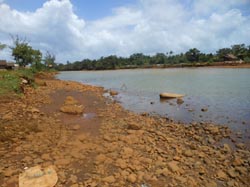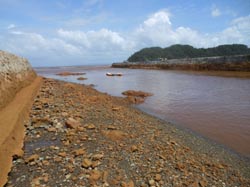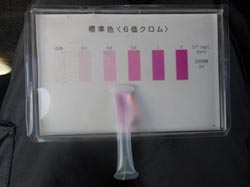Water Contamination Found in the Communities surrounding the Nickel Projects in Surigao del Norte, the Philippines
------ The Result of Water Analysis in February 2013
April, 2013

Water sampling location No. 6, or the month of the Taganito river (February 2013)
FoE Japan, with the cooperation of a Japanese citizen’s expert, has been continuously analyzing the water quality in the communities surrounding the Nickel Processing Plant Projects and the Nickel Mining Projects since 2009, which the Japanese companies have got involved in.
Last February 2013, we have analyzed the river and drinking water in the communities surrounding the proposed Taganito Nickel Processing Plant Project and the Taganito Nickel Mining Project, in the municipality of Claver, Surigao del Norte. The analysis in this area was the second time, following the one conducted in May 2012(following the one conducted in May 2012).
As a result, water contamination by hexavalent chromium has been found again at almost the same level as in the last research in May 2012. Hexavalent chromium is known as high toxicity due to carcinogenicity, liver damage, and skin disease etc..
It is found that hexavalent chromium or Cr (VI) in the Hayanggabon River and the Taganito River in this area exceeded the environmental standards in Japan, or “Environmental Quality Standards Concerning the Protection of the Human Health” (not exceeding 0.05 mg/L), which is the same situation as found in our last analysis in May 2012.

 Water sampling location No. 5, or the month of the Hayanggabon river (February 2013) (left)
Water sampling location No. 5, or the month of the Hayanggabon river (February 2013) (left)The result of examination by simple detector tube for hexavalent chromium in the Hayanggabon River (0.3 mg/L) (February 2013)(right)
Also, FoE Japan has analyzed several water samples which the local community has been using in the resettlement site of the Mamanwa people. (The resettlement site was prepared by the Taganito Mining Corporation.) As a result, hexavalent chromium at the highest possible standard level of the Japanese Water Supply Act and the World Health Organization (WHO) Guidelines for drinking-water quality (not exceeding 0.05 mg/L) was found.
According to the company, the water near the resettlement site is supposed to be used as only domestic water. Based on FoE Japan’s interviews with some residents this time, however, some residents don’t know that the water cannot be for drinking and they are still drinking the water in fact. It is implicated that the water, which has been continuously contaminated by hexavalent chromium, has been used by the local people as domestic and drinking water.


The resettlement site for the Mamanwa people (February 2013) (left)
Water sampling location No. 2, or the water which the Mamanwa people can get in front of the resettlement site (February 2013) (right)
Further, the expert said based on the analysis this time, “Given that the same kind of contamination had been found in the area of Rio Tuba, Palawan (which the Japanese companies have also got involved in), the hypothesis could be built up that the open-pit mining exploitation of laterite peculiar to the tropical region inevitably brings about the contamination of hexavalent chromium anywhere. In any case, any immediate countermeasures must be taken in the nickel mining sites and processing plants in Palawan and in Mindanao.”
From the viewpoint of preventing the long-term health damage and ensuring the security and life of the local people in the future, it is highly recommended that the Japanese companies and public agencies concerned, such as JBIC and NEXI, take immediate measures, such as the identification of the water contamination mechanism in order to establish appropriate anti-pollution measures.
(Reference)
Please see the detailed result and comments of the latest water analysis (in February 2013) by the expert at the following site;
- Result of Water Analysis (in February 2013) (by Mr. Junichi Onuma, Lecturer of Kinjo-gakuin University / Former Principal Investigator of Environmental Investigation Center in Aichi Prefecture)
- Map of Locations of Water Sampling in Surigao del Norte (February 2013)

